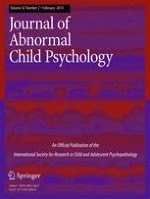01-02-2014
Adolescent Conflict as a Developmental Process in the Prospective Pathway from Exposure to Interparental Violence to Dating Violence
Gepubliceerd in: Research on Child and Adolescent Psychopathology | Uitgave 2/2014
Log in om toegang te krijgenAbstract
Within a developmental psychopathology framework, the current study examined adolescent conflict (age 16) with families, best friends, and dating partners as mediators in the prospective pathway from exposure to interparental violence (EIPV) in early childhood (0–64 months) to dating violence perpetration and victimization in early adulthood (age 23). Adolescent conflict was predicted to partially mediate EIPV and dating violence with significant direct paths from EIPV to dating violence, given the extant literature on the salience of early childhood EIPV for later maladjustment. Participants (N = 182; 99 males, 83 females; 67 % Caucasian, 11 % African-American, 18 % other, 4 % unreported) were drawn from a larger prospective study of high-risk mothers (aged 12–34 years) that followed their children from birth through adulthood. EIPV and adolescent conflict were rated from interviews with mothers and participants, and dating violence (physical perpetration and victimization) was assessed with the Conflict Tactics Scale. Path analyses showed that EIPV in early childhood (a) directly predicted dating violence perpetration in early adulthood and (b) predicted conflict with best friends, which in turn predicted dating violence perpetration. Although mediation of best friend conflict was not evident, indirect effects of EIPV to dating violence were found through externalizing behaviors in adolescence and life stress in early adulthood. Findings highlight that conflict with best friends is affected by EIPV and predicts dating violence, suggesting that it may be a promising target for relationship-based interventions for youth with EIPV histories. Furthermore, deleterious early experiences and contemporaneous risk factors are salient predictors of dating violence.
